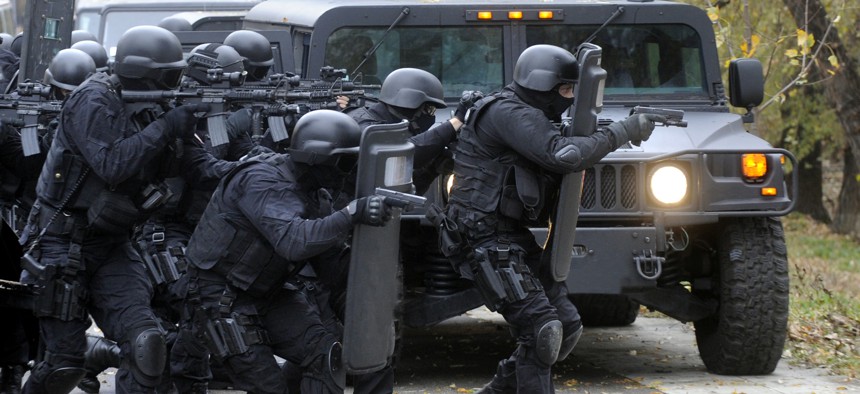
SHUTTERSTOCK / BIBIPHOTO
Military Wants X-Ray Vision and Tunnel Robots To Fight Terrorists
The Combating Terrorism Technical Support Office has released their wish list for 2016 and beyond.
Going after terrorists has never been a simple or straightforward affair, but does it really require something called “laser doppler vibrometry?” Affirmative, according to the Combating Terrorism Technical Support Office, or CTTSO, which released its new broad agency announcement on Dec. 18. This year’s edition of the annual announcement, which outlines the various gadgets and tech that the office is looking to buy or build, reads like a prop list for a Marvel Comics movie — and yet they’re also technologies that could eventually make their way into wider commercial use. So what does the future of counterterror tech look like this year?
A helmet that gives bomb techs Terminator vision
Don’t you hate when you’re disarming an improvised explosive device and you have to drop what you are doing to make sure your oxygen tank isn’t running low? CTTSO wants a voice-activated “bomb suit helmet heads up display.” Basically, it’s a helmet that displays key pieces of information to the wearer in a way that doesn’t get in the way of the task at hand. Those bits could include details of the explosive device, radiological or chemical alerts, even the bomb tech’s heart and respiration rate, gathered from body sensors.
Similarly, the office wants a hands-free “augmented reality” navigation system for driving. Think Google Glass for driving a getaway car.
FitBit for soldiers under fire
Fast reaction team members, like the contractors that went in to secure U.S. installations in Benghazi in 2012, can’t always get on the radio when they’ve been hit. If they’re under fire or hiding, they may have to maintain radio silence. CTTSO wants “wireless health monitors” that soundlessly broadcast biophysical information about the wearer to a commander for at least six hours. The office also wants wearable chemical and biological sensors as well.
FitBit for cars and trucks
What happens when the courier you just sent out from your base carrying important evidence or something else is captured and you don’t hear about it for months? A bad situation gets worse is what. “Currently the only status communications come directly from the courier, leaving command center personnel unaware if the courier has been captured or injured and/or the controlled materials compromised,” the announcement reads. The office wants an automatic “vehicle intrusion detection system” that can collect and transmit thermal, motion, and other data.
A portable device that can track a gunshot to its source
“If subjected to incoming small arms fire, security forces gain an advantage when provided timely information regarding the firing source (bearing, elevation, range),” the announcement reads. Gunshot tracking systems already exist , but they’re big and generally immobile. CTTOS wants a system that can fit onto vehicles to give tactical teams an immediate sense of who is shooting at them from where.
Batman armor
Today’s body armor is heavy and bulky, which can be a real downer for special operations forces on covert missions. But the thing about those missions is people tend to shoot at you while you are carrying them out. CTTOS wants what they are calling a tactical standalone plate: “a lighter, thinner armor solution would enable greater mobility, lower visible signature, and the opportunity to carry other equipment due to the weight reduction” — but still stop an armor-piercing 7.62 x 51 mm bullet.
Tunnel bots and tunnel threat detection software
Israel is already experimenting with tunneling and snake robots to find and scope out underground passages on the Gaza strip.
CTTOS wants to put something similar on the United States border. In addition, it wants software to analyze the “mechanically-bored tunneling threat,” as well as X-ray scanners to “locate tunnel entrances/exits and other man-made voids … and drug and weapon caches concealed in the floors and walls of buildings and underground municipal infrastructure.”
A laser vision system that can recognize a person by their chest shape from 200 meters away
If you’ve never heard of “laser doppler vibrometry,” you’re not alone. It bounces harmless laser beams off a target to produce a digital picture of the surface, sort of like a blind person using their fingers to identify a face. CTTOS wants a laser doppler vibrometer sensitive enough to positively identify a person by his or her upper torso “unique cardiological signature” in 60 seconds from more than a football field away.
A search engine that will tell you if a specific person is breaking the law
Before you decide that the country in which you are operating probably won’t bring charges against the insurgent mastermind you’re tracking, you may want to consult the Foreign Criminal Law Analytical Capability. CTTOS envisions this as a database that you search to compare the behavior of a particular person to “relevant foreign criminal statutes/regulations.” You can also look up how willing a given government might be to enforce those regulations.
In addition to the above, CTTOS’s wish list includes more mundane and predictable fare like data analysis and fusing, secure communications, etc. But the most revealing item isn’t technological at all; it’s a request for analysts’ best guess as to how counterterrorism operators will proceed in a future environment where enemies are much more able to use consumer technology against them. The request is for “a descriptive report that defines and describes the … 'highly contested' and 'austere' information environment envisioned in 2025 to 2035.”
Technology giveth and technology taketh away.
